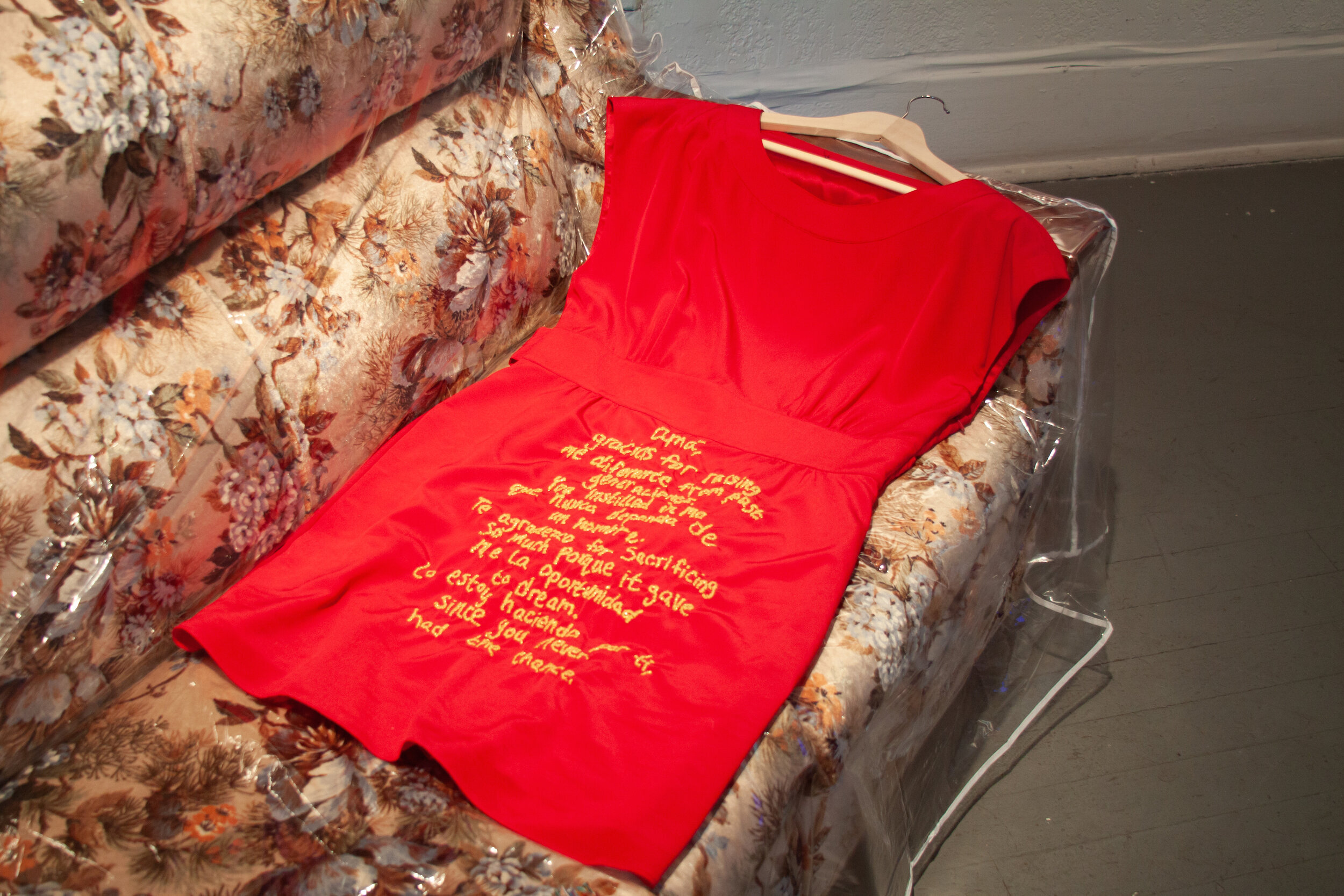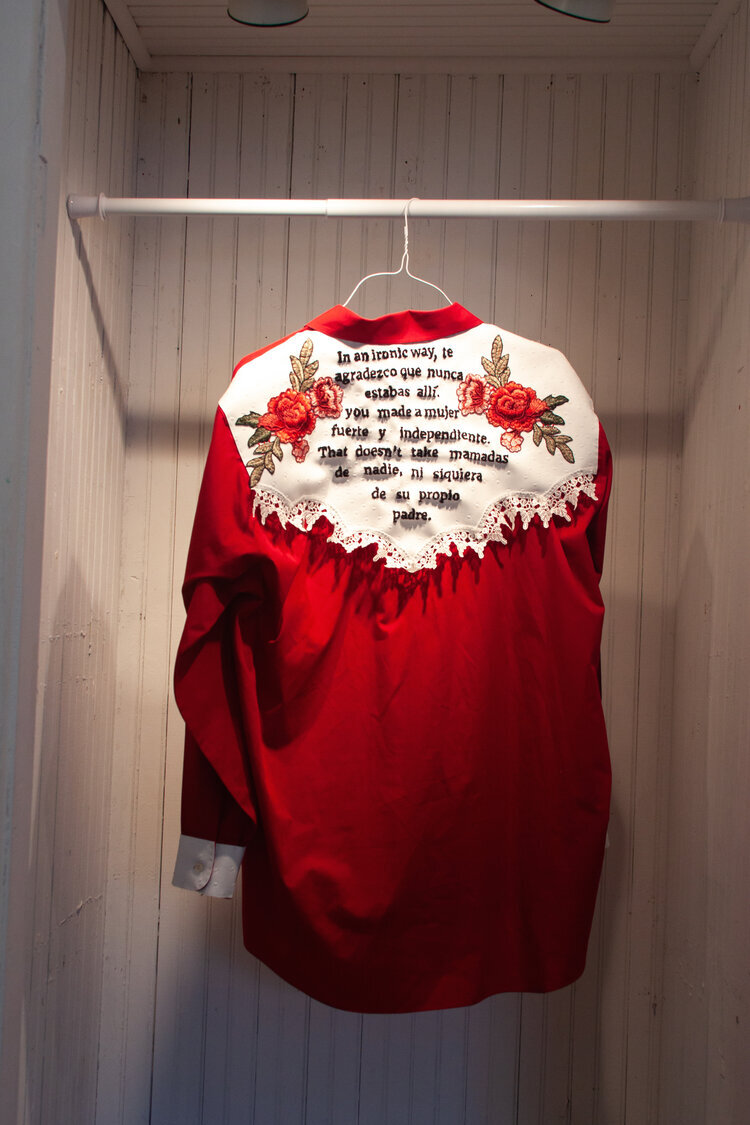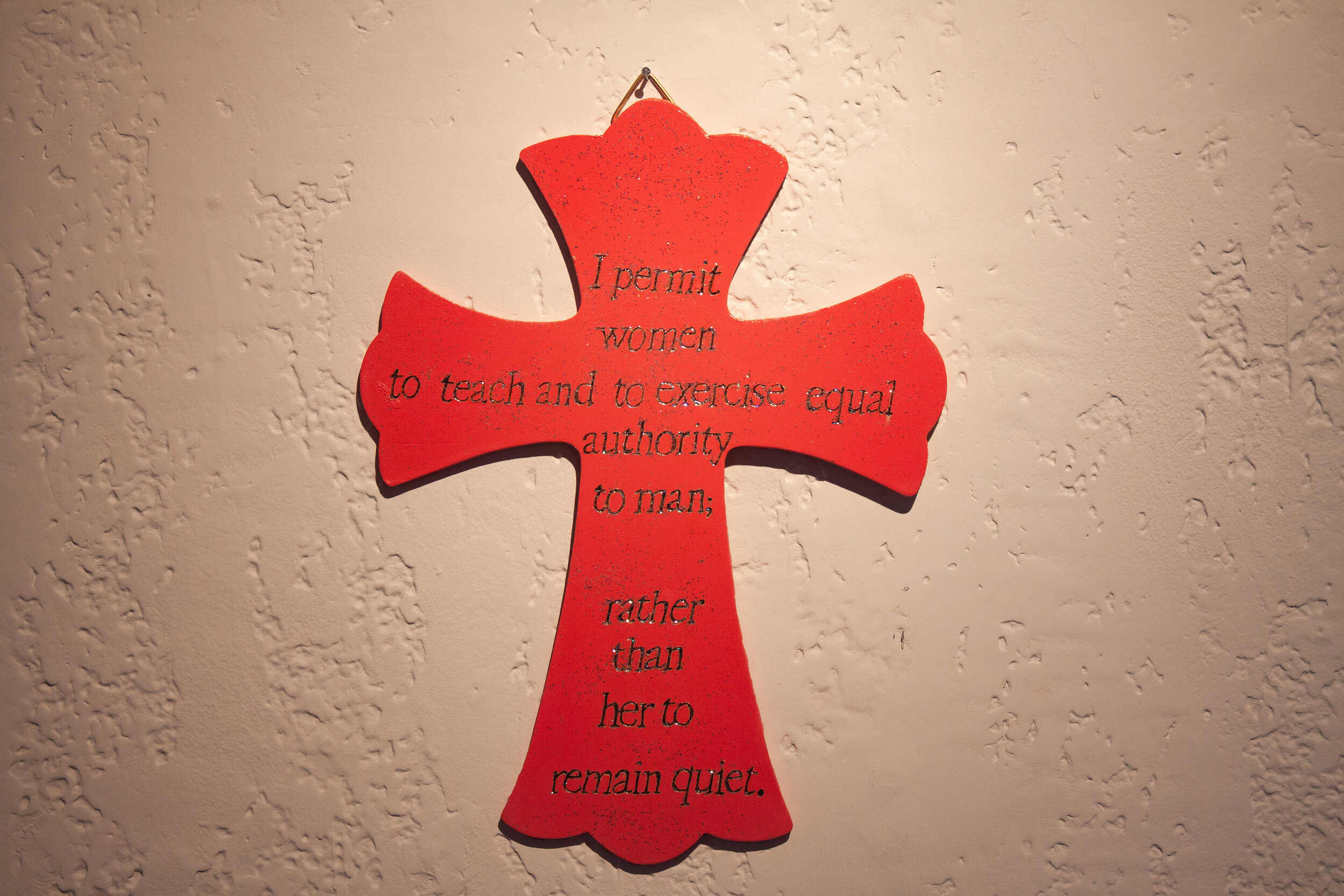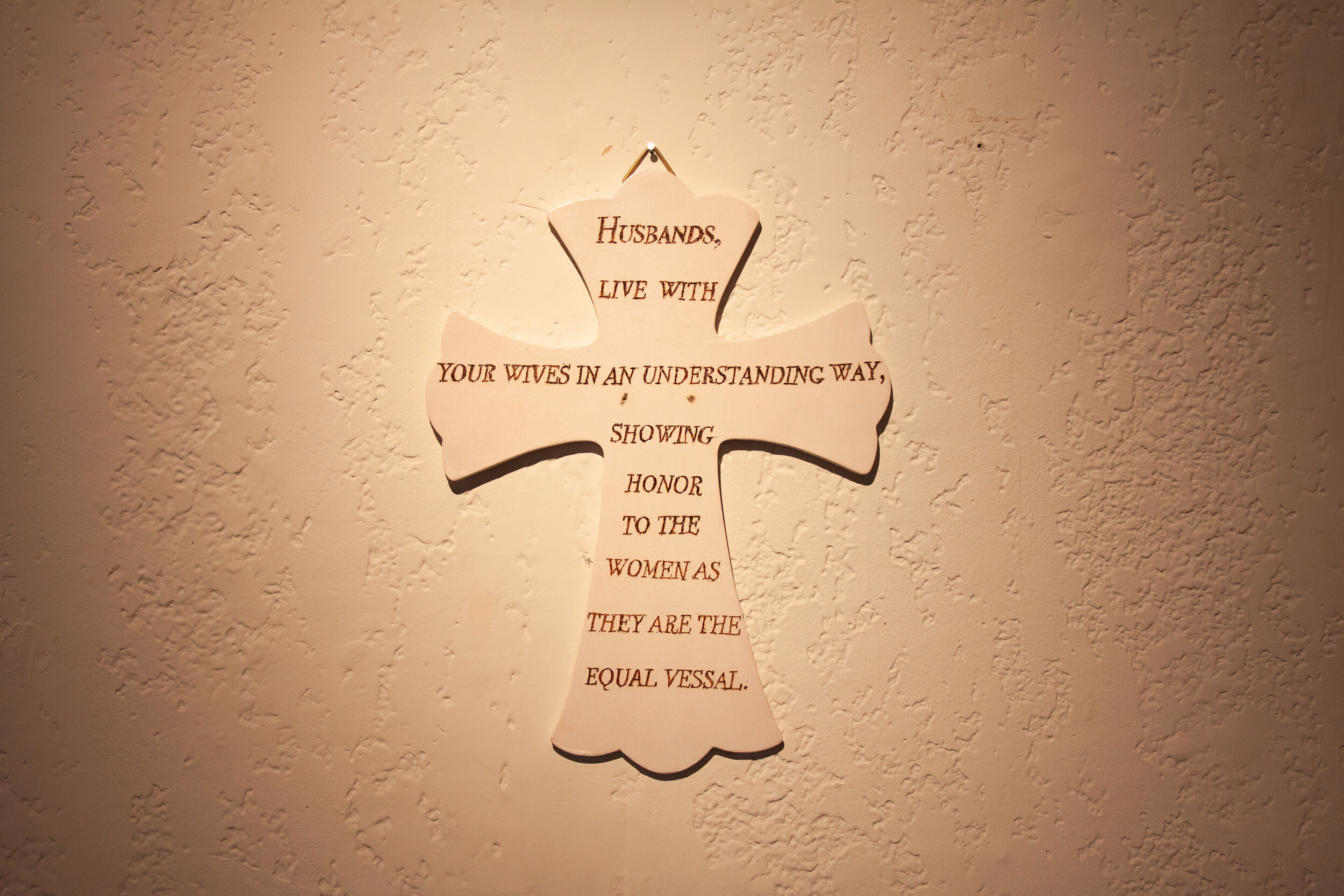Q&A: Gabi Magaly
By Hamidah Glasgow | July 30, 2020
Gabi Magaly is an emerging artist born in Bryan, Texas. Magaly received her BFA in photography at Sam Houston State University in 2015 and received her MFA in Visual Arts at the University of Texas at San Antonio in 2020. Magaly has exhibited in solo shows at Satellite Gallery, Huntsville, TX; The Brick, San Antonio, TX; Presa House Gallery, San Antonio, TX; Casa Lu, Mexico City. She works predominantly in the medium of photography, but also employs other mediums like sculptural installation and embroidery. Magaly currently lives and works in San Antonio, Texas.
Growing up in a Mexican-American household, my childhood was saturated with the machismo and marianismo culture. Hypermasculinity oozes brutality, control, and bad cologne. Placated and tongue-biting women don’t speak up, act up, and always have rice and tortillas on the table at precisely six o’clock. Daughters are raised to submit to men, are being taught to fetishize purity and holiness. We are expected to feed stomachs, ego, and a taste for violence. With my work, I draw from my experience within this toxic culture and provide a call to action for the women who don’t have a voice to feel empowered and for the men with a little too much to say to be softened. The imagery I use within my work references the everyday accessible household items that are traditionally associated with my Mexican-American household. I want these items to be culturally and physically accessible. A visual language usually reserved for Abuela’s kitchen and living room is transformed into defiance, empowerment, and hopefully change. As we look towards the future, my work encourages women in my culture to find the strength to forget about the old traditions and raise their daughters to be independent. Gabi Magaly
Hamidah Glasgow: Gabi, thanks for taking the time to chat. You have the unique perspective of getting your MFA during the pandemic and missing out on the final thesis exhibition. I want to talk about that later but want to start by asking about your path to photography and becoming an artist. What has that path looked like for you?
Gabi Magaly: I went to an early college high school that helped guide students in going to school for traditional majors, and I didn't know what I wanted to do, but I knew I didn't want to go to a school that ended up with me in a 9-5 office job. So when I took 2-D foundations with Ms.Hext that changed everything for me because she saw something in me, I didn't know I had. She told me that I could go to college for art, and I didn't believe her because not once did my other teachers mention this to me. So when I finally decided that I did want to go to school for art, my principal wasn't too happy because she didn't want to spend any more money on art supplies. She told me that this school wasn't for me and that I should go to another high school. I didn't. After being told that art wasn't a career by the person that should be encouraging, you did mess with me for a while, but in a petty messed up way, it pushed me to follow what I wanted in life that was to be an artist. After I graduated high school, I went to Sam Houston State University for photography. That was a very different world then what I was used to because this was art school where I was doing four studios class vs. one art class a semester.
Undergrad was hard because I always compared myself to the seniors and where they were in their careers. I had imposter syndrome really bad because I was the only one doing art in high school, and now I was surrounded by it and didn't know what I wanted to say just yet in my work. It was hard for me because I was SHY I didn't really talk to anyone, thought my work sucked, and didn't know what I was doing a good chunk of the time and didn't know how to ask for help without looking dumb. I was in undergrad for 3 ½ years, and the first three was just that always doubting myself. But the last semester is where I found something that was passionate about, and that's where everything changed in my art-making. My undergrad professor told us about going to grad school and that she really wanted me to go. I eventually went to grad school, but I took a year and a half because I was so burnt out on college, and I knew I would have quit from the research that I've done on getting your MFA.
Nothing exciting happened during that break, but I learned that working at a coffee shop was not what I wanted for the rest of my life. So that lit a fire under my ass to go back to school and actually do art as I planned. I was accepted into the University of Texas at San Antonio, and grad school has honestly been the best decision I've made because I finally found out what I wanted to really say in the artwork. I was learning to be happy away from my machismo father. The road to being an artist hasn't been easy because I still have imposter syndrome, but not as bad. There's been a lot more No's than Yes's, being told by a white man that "If I saw this work in a gallery, I would dismiss it right away," not being able to find where I belong in the art world till I came to San Antonio. But every No motivated me more to show my work and let my voice be heard. It hasn't been easy, but I wouldn't trade it for the life that my high school principal and dad wanted for me.
HG: With an overarching theme of pushing back on Machismo and embracing freedom from that culture, how did you learn to push back, and what does that trajectory look like moving forward?
GM: All I knew was that I wanted to go to school, and my father didn't want me going because I would be wasting my time and money that instead, I needed to settle down and start a family already. It's hard being the black sheep in the family and doing something that is not traditional in a Mexican household. I was considered a rebel or being told: "con el nopal en la frente" (cactus on the forehead) that is usually told to a Mexican when they are "losing" their roots or being whitewashed. Growing up in a machismo household has been very negative when it comes to talking about my feelings. So when I came to grad school, I stopped talking to my dad because he wasn't helping me with anything, which added to my stress. I knew I couldn't talk to my family about how it affected me, so I started making work about it. At first, my work was very angry and mean because that's how I felt towards everything my dad has ever done to my family and me. It was until my professor told me something that I've never heard about myself and that I was a strong chingona that has a lot of important stuff to say and that I should talk about how growing up in a machismo home made me a strong woman that doesn't take shit from anyone. When he told me, that's where everything in my art practice changed into a positive outlook. I started to make work about me being a strong and independent woman because that's the message I needed growing up, not my old work of being angry all the time because then my dad would win and didn't want that. All the work that I make now has to be positive or talking about my feelings because I'm making it for young Gabi and all the future daughters that need to hear that they are worthy and strong, that they don't need to depend on anyone or put up with any one's bullshit. That they don't have to follow their family traditions and that there is nothing wrong with being selfish and wanting more in life than what your family wants for you. I just want my work to be seen and have people relate to it and know that they are not alone in this terrible machismo world.
HG: Your words are a testament to the power of our words to help or harm people. Having a great teacher that sees your promise can be life-changing. I'm glad you had that and that you followed your gut and their advice. Imposter syndrome is real, and people experience it at all levels of their careers.
Let's talk about your thesis work and the room that you created. How did that all come together?
GM: In March of 2019, I asked Rigo from Presa House if I could show at their gallery because I wanted a space that was an actual home vs. the traditional white gallery walls. I really didn't know what I wanted to do with, but I just wanted that space for the home environment. The ideas slowly came to me after knowing I was going able to show in that space. I started writing in my journey about every feeling I've ever had that I wasn't able to express as a kid and came up with almost everything in the show from my writings. I came up with the living room installation because I've always wanted to tell my dad how I felt about everything he has done to me but never wanted to tell him, so I recorded voicemails to him. One day I want to send him the messages, but I know he never will emotionally understand why I have these feelings towards him. So I put the messages on an actual voicemail machine on an end table that I remember seeing when I was young. And the rest of the living room fell into place like the plastic cover couch, the red lace curtains, and big-box TV. But everything in the room had to have some meaning tied to my childhood. I wanted it to feel like walking into my Abuelita's actual home and realize it's my childhood trauma and how I'm learning to deal with it now as a woman.
The bedroom idea came to me when I wanted to do something with my quinceanera dress that I made a promise to La Virgen De Guadalupe. It was funny because my mom didn't want to give me the dress because she knew I was going to make art out of it. But she finally caved in and let me have it. I found out that my great-grandma used embroidery when she was young, so I came up with the idea of embroidery on the dress. I decided to place the dress on the bed that had a blanket from my "Mi Religion" series. The blanket I picked was my modern-day version of "La Virgen de Guadalupe." That room means a lot to me because I promised my virginity in that dress, and I wanted to make a new promise to myself and love myself and never feel ashamed of enjoying sex.
I was bummed out that people didn't get to see the show because we just started lockdown in Texas. But Rigo knew how hard I worked for this and wasn't about to let COVID stop the world from seeing my work. He did everything he could and was able to have a friend, Nain Leon, to create a virtual tour. It came out so good! I was happy that more people could see the work vs. it just being seen in San Antonio. It was well-received to where I was rewarded 2 CAMMIE awards presented by Blue Star and Luminaria. I cried when I found out because I remember wanting to win a CAMMIE award when I moved to San Antonio. It was surreal because everything was being canceled, and I was finally feeling proud of myself after everything I'd gone through.
HG: This spring, you did a residency in Mexico, tell me about that experience and the work that you created while there.
GM: I did my first residency at Casa Lu in Mexico City, and it was amazing, and I loved it! Yea, I couldn't go out and explore the city, but I was able to finish grad school in a weird way. If that makes sense? Because we had to leave our studios in such a rush in March, we weren't able to say goodbye. To wake up, eat breakfast and make art till you get hungry again was a dream come true! I loved living in a house full of artists just making art! It was great.
The work that I created while I was there was what I couldn't finish for my thesis show or ideas that grew from what was created from the show. I feel in love with embroidery and feeling more comfortable about sex, so I embroidered images of myself masturbating on everyday objects that I saw around my Abuelita's house. Creating this work was interesting because I learned a lot about the clitoris and orgasms. Growing up, we never talked about sex, just a cut and dry talk about where babies come from, and that's it. It took me meeting my boyfriend to learn what my body was capable of, and it shouldn't have been like that. So I created this work to be in a space where sex should be talked about and for it to be healthy for women to enjoy sex and know the full anatomy of the clitoris. I'm proud of this work because I'm finally comfortable in my body and love having orgasms! :D
“I invite guests into this place where the objects installed create an experience of a new normal; of women celebrating their bodies casually and unabashedly. It may seem shocking to some, but if we all start educating ourselves about the amazing body part that is the clit, it is just the beginning of a conversation. Otherwise, it’s an unspoken expectation that women are at their greatest baby factories and have been shamed against exploring their bodies and enjoy sex.”
HG: Thank you for the interview and working to change the narrative!
GM: Thank you!
All images © 2020 Gabi Magaly












